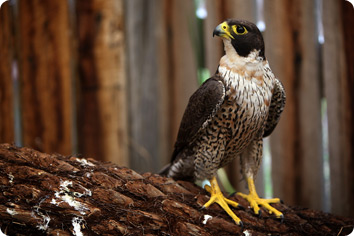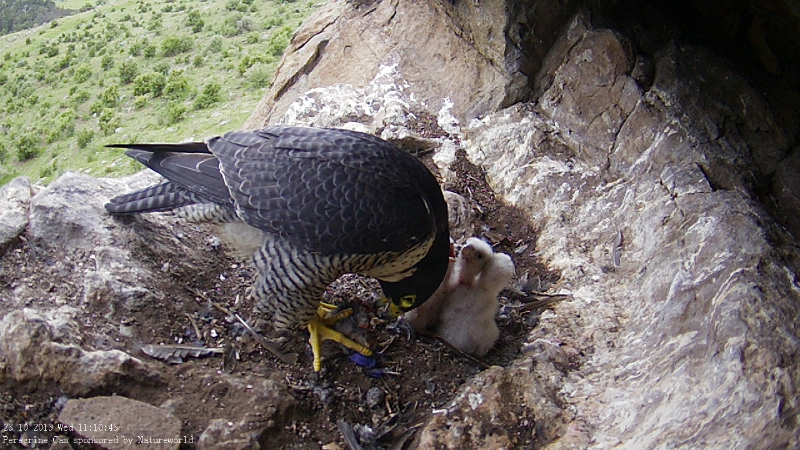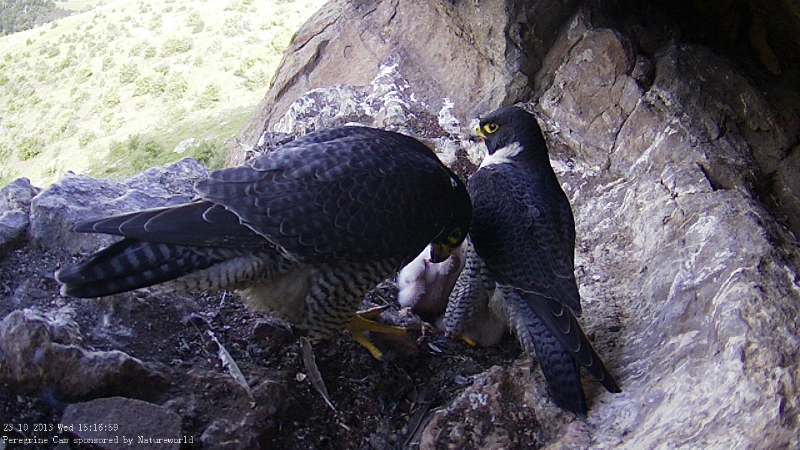Peregrine Falcon
The Peregrine Falcon (Falco peregrinus) has a body length of 34 to 58 centimetres (13–23 in) and a wingspan from 74 to 120 centimetres (29–47 in). The male and female have similar markings and plumage, but as in many birds of prey, the Peregrine Falcon displays marked reverse sexual dimorphism in size, with the female measuring up to 30% larger than the male. Males weigh 424 to 750 grams (0.93–1.7 lb) and the noticeably larger females weigh 910 to 1,500 grams (2.0–3.3 lb); for variation in weight between subspecies, see below. The standard linear measurements of Peregrines are: the wing chord measures 26.5–39 cm (10.4–15 in), the tail measures 13–19 cm (5.1–7.5 in) and the tarsus measures 4.5 to 5.6 cm (1.8 to 2.2 in).
The back and the long pointed wings of the adult are usually bluish black to slate grey with indistinct darker barring; the wingtips are black. The white to rusty underparts are barred with thin clean bands of dark brown or black. The tail, coloured like the back but with thin clean bars, is long, narrow, and rounded at the end with a black tip and a white band at the very end. The top of the head and a “moustache” along the cheeks are black, contrasting sharply with the pale sides of the neck and white throat. The cere is yellow, as are the feet, and the beak and claws are black. he upper beak is notched near the tip, an adaptation which enables falcons to kill prey by severing the spinal column at the neck. The immature bird is much browner with streaked, rather than barred, underparts, and has a pale bluish cere and orbital ring.
Feeding
The Peregrine Falcon feeds almost exclusively on medium-sized birds such as pigeons and doves, waterfowl, songbirds, and waders. Worldwide, it is estimated that between 1,500 and 2,000 bird species (up to roughly a fifth of the world’s bird species) are predated somewhere by these falcons. In North America, prey has varied in size from 3-g hummingbirds to a 3.1-kg Sandhill Crane (killed by a peregrine in a swoop). Smaller raptors are regularly predated, including smaller falcons such as the American Kestrel. In urban areas, the main component of the Peregrine’s diet is the Rock or Feral Pigeon, which comprise 80% or more of the dietary intake for peregrines in some cities. Other common city birds are also taken regularly, including Mourning Doves, Common Wood Pigeons, Common Swifts, Northern Flickers, Common Starlings, American Robins, Common Blackbirds, and corvids (such as magpies or Carrion, House, and American Crows). Other than bats taken at night, the Peregrine rarely hunts mammals, but will on occasion take small species such as rats, voles, hares, shrews, mice and squirrels. Coastal populations of the large subspecies pealei feed almost exclusively on seabirds. In the Brazilian mangrove swamp of Cubatão, a wintering falcon of the subspecies tundrius was observed while successfully hunting a juvenile Scarlet Ibis. Insects and reptiles make up a small proportion of the diet, which varies greatly depending on what prey is available.
The Peregrine Falcon hunts at dawn and dusk, when prey are most active, but also nocturnally in cities, particularly during migration periods when hunting at night may become prevalent. Nocturnal migrants taken by Peregrines include species as diverse as Yellow-billed Cuckoo, Black-necked Grebe, Virginia Rail, and Common Quail. The Peregrine requires open space in order to hunt, and therefore often hunts over open water, marshes, valleys, fields, and tundra, searching for prey either from a high perch or from the air. Large congregations of migrants, especially species that gather in the open like shorebirds, can be quite attractive to hunting Peregrines. Once prey is spotted, it begins its stoop, folding back the tail and wings, with feet tucked. Prey is struck and captured in mid-air; the Peregrine Falcon strikes its prey with a clenched foot, stunning or killing it with the impact, then turns to catch it in mid-air. If its prey is too heavy to carry, a Peregrine will drop it to the ground and eat it there. Prey is plucked before consumption.

Nesting
Although on mainland Australia some peregrines nest in old eagle nests or even hollow trees, essentially the species nests on cliffs on ledges and in potholes. All confirmed nests in Tasmania have been on cliffs. A site sheltered from heavy rain or high chill-factors is preferred and just a scrape is made to lay eggs. Clutch size varies from 2-4. Eggs are laid every second day and incubation proper starts with completion of the clutch, lasting for about 32 days. Most eggs hatch and males fledge at about 40 days old if left to their own devices, and females about 43 days. After fledging, juveniles are dependent on their parents for 4-8 weeks, gradually dispersing. Females disperse further than males. Not all nests are used every year but those of the highest quality are permanently occupied. Post dependence mortality is naturally high (about 50% in the first year) but this decreases with experience gained. Males become mature at 3 years old and females at 2 and they can then expect to live for another 4-8 more years.
Tasmania is a great place for Peregrines but far from the best. Our nesting population recovered from ravages of organochlorine pesticides in the 1960s,1970s and into the 1980s and persecution from the 1930s, through legal protection (of the falcons) in the early 1970s to now, with perhaps 120 breeding pairs, which translates from a seasonal high of about 700 individuals to a seasonal low of about 600. Our population has been relatively stable for some years now. Most are clustered in river valleys and along suitable coastline and on inshore islands and where close (less then 4km apart) pairs tend to be evenly distributed since they are highly territorial. Nests are fiercely defended even against people.
A ‘Wi-Fi’ nest
Nick Mooney, Wildlife Biologist, worked with Natureworld in 2013, to monitor a Peregrine Falcon nest, and describes the project:
“The cliff pothole nest site that is the subject of this remote, wi-fi camera has a typical clutch of 3, just as typically completed on the 16th September and hatched 18-19th October. The adults are not leg ringed or otherwise marked – that phase of our research ended many years ago so all I can say is they are at least 2 years old for the female and 3 for the male. They seem unusually attentive, especially so the (smaller) male who tries to brood more often than usual, although already the chicks are getting too large for him.
“So far the male has been doing virtually all the hunting while she stands guard and prey has been nearly exclusively starlings with a few rosellas (both eastern and green), a noisy miner and a skylark, a typical mix for this nest in the past and this rural habitat. Once the chicks are about 3 weeks old they are large enough to defend themselves against nest raids by ravens and conserve heat so they can be left alone for longer. They also naturally demand more food and the female will start hunting then. Larger prey such as masked lapwings and galahs may consequently appear. Typically, food is provided every few hours of daylight – mostly it is fresh caught but sometimes it is leftovers or food cached nearby.
“This educational project has been set up to avoid the necessity for approval from an Animal Ethics Committee by using a static, remote camera without manipulation of the birds. The very high fidelity, persistence and resilience peregrines show to low levels of disturbance is also a key asset of the project, taken advantage of through my extensive experience with this species and the generosity, expertise and experience of Simon Plowright of Natureworld.
“The nest is on private property and permission for access is very limited. It is a nest well known to locals and has been the subject of past persecution so I judge no or very little increased security risk from this project. The species is wholly protected by law and I and others monitor the site. We also have other cameras secretly installed nearby to help us monitor security.”








